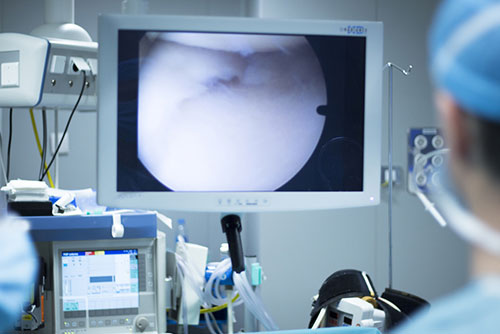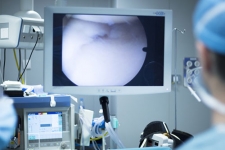
The Steps
The type of anesthesia used will depend on the duration of the procedure. There is local anesthesia (blocks a limited area, like a knee) regional anesthesia (numbs the lower half of your body) and general anesthesia (places the patient unconscious).
An arthroscope basically makes everything “bigger” or more visible for the surgeon. The surgeon will first make multiple small incisions that will act as entry points for the surgical tools. Small tools that hold light small lighting systems will first be inserted to illuminate the joint. Then, a small camera is placed on the end of a pencil-sized instrument and inserted through another small incision to view the damaged joint. This small camera is attached to a larger monitor close to the doctor so he can view the joint on a bigger picture. Just like you use your computer to complete your work, surgeons use large monitors to repair your knee.
From here, the surgeon will repair the damaged areas. The surgical tools are then removed and the incisions are stitched or closed with adhesives.
What’s it for?
Since the word “arthroscopy” essentially means to look at a joint, this procedure is almost exclusively conducted on joints. This surgery is commonly used for conditions such as:
- Damaged tissue
- Loose bone fragments
- Repairing nagging scar tissue
- Torn ligaments
- Inflammation
To simply view the damage before surgery.
This can include common injuries such as:
- ACL, MCL, LCL, and PCL Surgery
- Dislocation
- Rotator Cuff Tears
- Joint Impingements
But it can be used for other injuries. For example, Boston Celtic’s Point Guard, Kyrie Irving, recently had two screws removed from his left kneecap after signs of a bacterial infection on the screws.
How to prepare?
Your doctor will give you a list of steps before the surgical procedure. You should avoid any medications and supplements that medical professionals say, have a ride home prepared as you will be unable to drive for a few weeks, wear loose and comfortable clothing to make dressing for the procedure easier, and you may be required to fast beforehand depending on your anesthesia
What are the risks?
Arthroscopic surgeries are among the safest in the medical world, with less than one percent experiencing problems. Some of the problems that do arise on rare occasions are infection, excessive swelling, or damage to the blood vessels or nerves.
After the procedure
The average arthroscopic patient can expect to be at light activity levels within a few days, but it will take a few weeks to engage in more strenuous activities. Much of the recovery process depends on the surgery and each individuals healing process.

